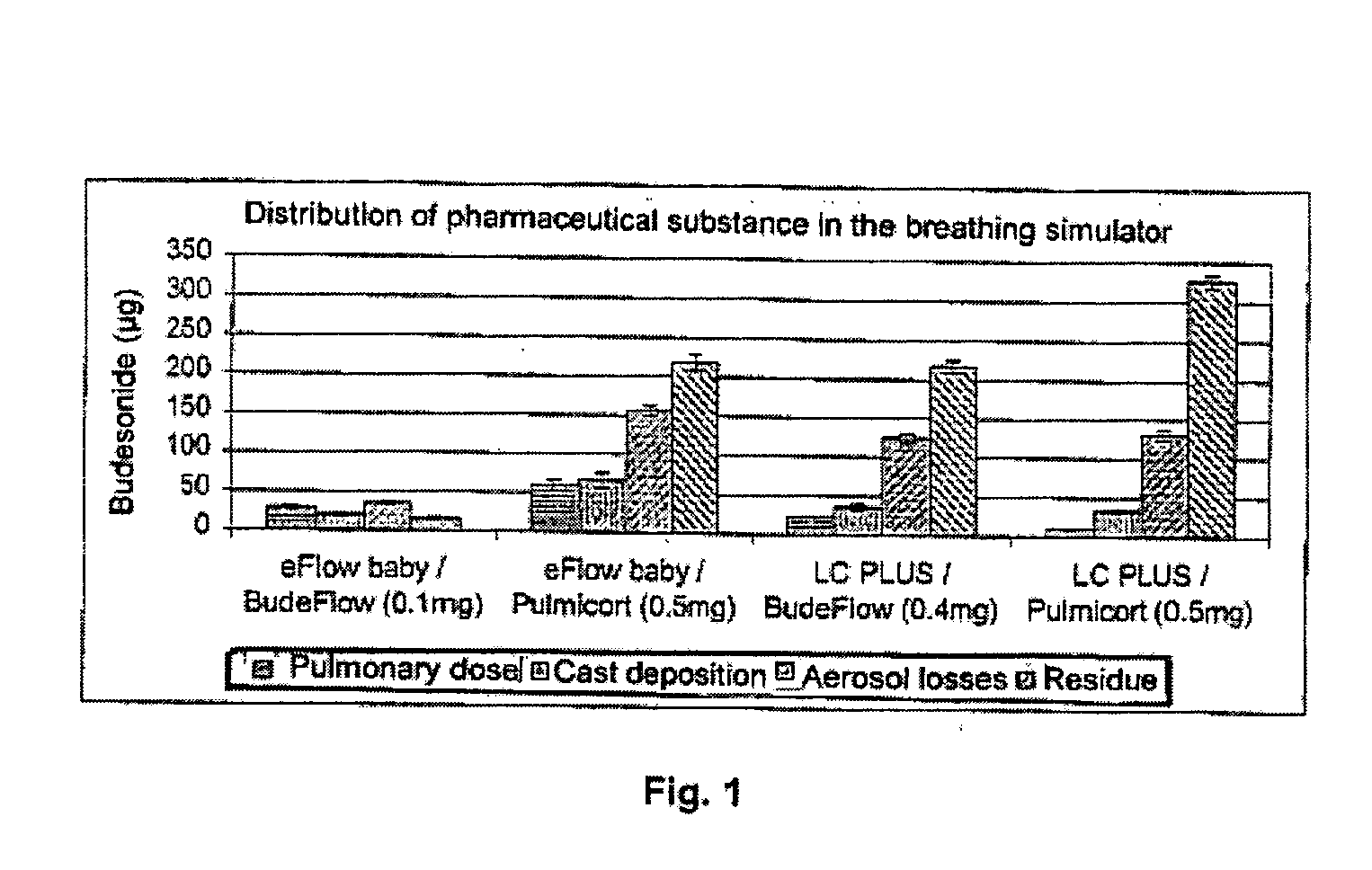Pharmaceutical aerosol composition
a technology of aerosol and pharmaceuticals, applied in the direction of aerosol delivery, drug compositions, dispersed delivery, etc., can solve the problems of aerosol being released with a velocity of up to 100 km/h, metered dose inhalers are usually not suitable, and aerosol is released with a high speed
- Summary
- Abstract
- Description
- Claims
- Application Information
AI Technical Summary
Benefits of technology
Problems solved by technology
Method used
Image
Examples
example 1
Solubilization of Budesonide with Tyloxapol and DMPC
[0178] Buffered aqueous solutions of tyloxapol, DMPC and tyloxapol in a mixture with DMPC were prepared. The saturation solubility of budesonide in these solutions was measured by adding an excess of budesonide and treating the sample with heat and ultrasound and subsequently allowing it to stand for equilibration. The equilibrated samples were filtered through a membrane filter with a poor width of 0.22 μm and the content of budesonide in the filtrate was determined. Selected results from these experiments are shown in Table 1. The saturation concentration of budesonide in DMPC solutions could not be increased, even by further increasing the DMPC content.
TABLE 1Tyloxapol [wt %]DMPC [wt %]Budesonide [μg / ml]01201.5020410.5268
example 2
Preparation of a Sterile Colloidal Solution of Budesonide
[0179] Budesonide is an example for a poorly water soluble active agent which can advantageously be formulated as a colloidal aqueous solution by the combination of surfactants according to the invention.
[0180] The starting materials shown in Table 2 were provided in the stated amounts. The stated starting materials, except for budesonide, were fast dissolved or dispersed in the water for injection by stirring with a magnetic stirrer. Subsequently, the batch was homogenized for 10 minutes at 1500 bar with a high pressure homogenizer. This gave an opalescent colloidal solution with a pH of about 4.5.
[0181] To this solution, previously provided 200 mg of budesonide were added. This batch was warmed to about 60-70° C. and, at the same time, subjected to ultrasonication for about 30 min. Thereafter, the batch was cooled to room temperature while stirring with a magnetic stirrer. Evaporated water was replaced by a corresponding ...
example 3
Preparation of a Budesonide Formulation for Nasal Application
[0186] 3.75 g of tyloxapol were weight into a 1000 ml glass beaker. 486.0 g of water for injection were added and it was stirred at room temperature (20° C.) until the tyloxapol had completely dissolved. 4.23 g of sodium chloride, 0.2 g of citric acid and 0.25 g of sodium citrate were added to the resulting solution. After dissolution of all components, the pH of the solution was adjusted to 4.3 by additional sodium citrate. 7.5 g of lipoid PC 14:14 (dimyristoyl phosphatidylcholine) were added to the solution and homogenized by Ultra Turrax at 11000 rpm (5 minutes). The formulation was subsequently homogenized for 20 minutes by high-pressure homogenization (micro fluidics M100EH) at 1500 bar. The resulting solution showed slight opalescence which nearly disappeared after 12 hours on the magnetic stirrer.
[0187] After addition of 400 μg / ml of budesonide, the formulation was again homogenized (Ultra Turrax followed by high ...
PUM
| Property | Measurement | Unit |
|---|---|---|
| particle size | aaaaa | aaaaa |
| particle size | aaaaa | aaaaa |
| polydispersity index | aaaaa | aaaaa |
Abstract
Description
Claims
Application Information
 Login to View More
Login to View More - R&D
- Intellectual Property
- Life Sciences
- Materials
- Tech Scout
- Unparalleled Data Quality
- Higher Quality Content
- 60% Fewer Hallucinations
Browse by: Latest US Patents, China's latest patents, Technical Efficacy Thesaurus, Application Domain, Technology Topic, Popular Technical Reports.
© 2025 PatSnap. All rights reserved.Legal|Privacy policy|Modern Slavery Act Transparency Statement|Sitemap|About US| Contact US: help@patsnap.com

